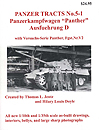| |
Panzer Tracts No. 5-1, Panzerkampfwagen
“Panther” Ausfuehrung D with Versuch-Serie Panther, Fgst.Nr.V2
by Thomas L. Jentz and Hilary
Louis Doyle
Panzer Tracts, ISBN 0-9708407-8-0, 72 pages

This is a superb reference for all modellers with any interest in the
Panther. It does not replace in any way The Panzer Tracts team’s
splendid Quest for Combat Supremacy, but does make a great addition to
it.
Here you get the story of the first Panthers, as always taken from the
original German archives without wartime intelligence speculation and
postwar mistakes. There’s no combat history here, just the facts
(did I say “just” the facts?) about the prototype Panthers
and the production Ausf D. The successive modifications are listed, with
all the known dates for them, and illustrated with photographs and Doyle
drawings.
Ah, those drawings! Let me give you the list. First 1 /135 four-view plan
of prototype V2, with its particular features noted, and for good measure
a separate 1/35 four-view of its turret alone to show more detail. Next
a set of German drawings (it’s best not to call them plans, for
as Tom Jentz points out in the text they include features of both Ausf
D and Ausf A) of the Ausf D. Then a Doyle five-view n 1/35 of an Ausf
D as completed by MAN in January 1943, followed by more Doyle plans of
a bare hull as delivered to the assembly plants and a complete plate layout
– that’s a Doyle plan of the plates laid out flat, suitable
for scratchbuilding your own hull if you want the ultimate accuracy as
it even marks the areas that were face-hardened!
The next seven pages give you the belly plate layout with all the inspection
plates etc, followed by LARGE drawings (no, not sketches, proper plan
drawings) of track links, wheels, tool racks, track hangers, and air vent
guards, etc. Move on a couple of pages and you’re faced with more
large drawings of the rear stowage bins, exhaust heat shields, rear plate
fittings and armoured exhaust guards. A couple of pages later and there’s
the Panther D turret in detail, with its plate breakdown too and more
large drawings of its cupola, ventilation fan guard, pistol and communications
ports and the escape hatch.
Further on again and you find more large drawings, of the tools, their
modified stowage racks, the schuerzen plates and their hangers, and even
the two approved rear side plate welding layouts. Those are followed by
the sprocket, wheel and track variations and changes, again to large 1/20
scale for clarity. Then there’s a 1/35 five-view of an Ausf D as
completed in June 1943 followed by more large drawings, this time of the
engine deck fittings and including the snorkel’s armoured cap that
has been a mystery for so long. After them you find the two- and three-plate
variations of the belly plate, then more large drawings of the cupola
hatch, driving compartment roof and the gun crutch. The last full plan
is a 1/35 five view of the September 1943 production standard Ausf D,
and finally the end cover has top views of prototype V2 and the first
production series Ausf D to show their differences.
All of this is accompanied by splendidly clear photographs with excellent
captions pointing out the features shown, and some interior ones too.
With those large drawing showing not only every bolt but also where they
had lock tabs detail fans can have a field day. There is no longer any
excuse for Panther modellers not to show their Kursk Panthers with the
correct configuration and then go on to build the Autumn style as well!
Since this is volume 5-1 we can hope to see the Auf A and Ausf G covered
in as much detail in further Panzer Tracts books, and I can hardly wait.
Very, very highly recommended.
John Prigent
|
|